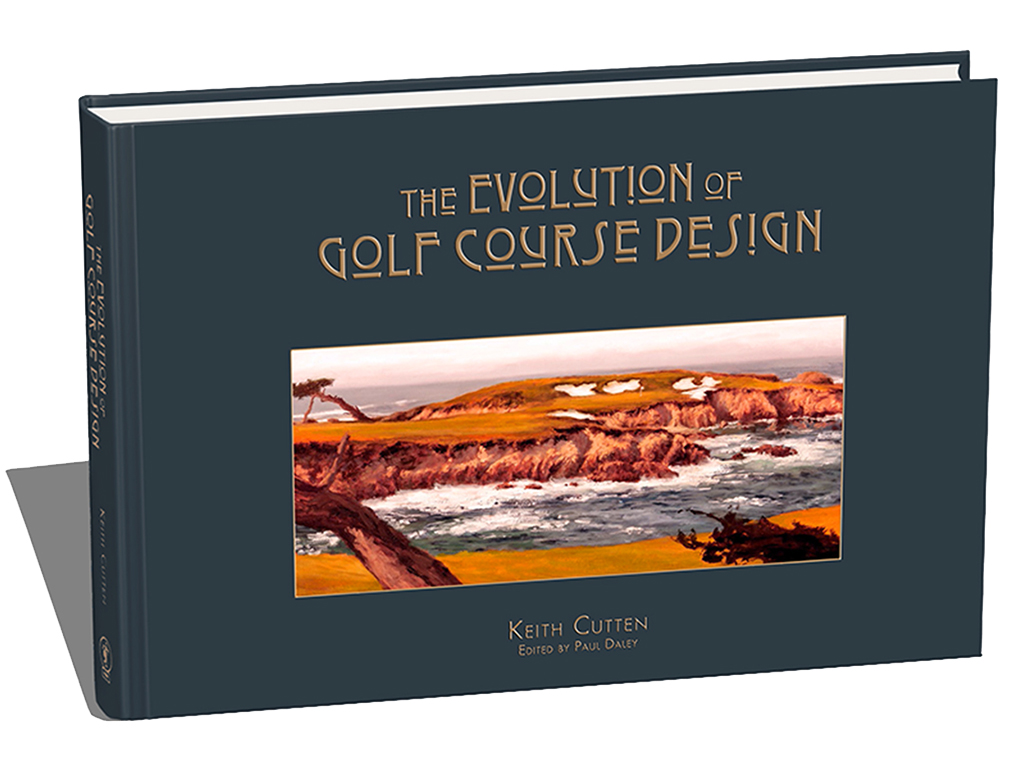News
An interview with Keith Cutten, author of “The Evolution of Golf Course Design”

This interview is with Keith Cutten, author of “The Evolution of Golf Course Design,” which is a new book he is releasing to the public. This is an unbelievably well-researched and all-encompassing look at golf course architecture, how it has changed throughout history, and all of the variables in play that have shaped it over the course of time.
Let’s start with the easy stuff. What’s your personal background? How did you get into all of this?
Well, my passion for golf architecture started back in high school. I took a drafting and design curriculum all through high school, which was hugely beneficial. I was getting into golf around 15-16 years old and I lost my grandfather, who was the primary golf influence in my life. When he died, he left me his golf clubs, and I missed him so much I just dove completely head first into golf.
When I finished high school, I sat down with my dad to try to hash out a game plan to get into the golf industry. My dad was an environmental scientist for 40 years with the Ministry of Environment in Ontario, so he helped me a great deal in understanding the policy system here in Canada. I started by getting my bachelor’s degree from the University of Waterloo in Planning and Environmental Design. In my last coop term, I went for broke and I reached out to Rod Whitman in Canada, who invited me to do a 5-month coop with him during the construction of Sagebrush Golf & Sporting Club in British Columbia. The pay was paltry and I ran a shovel and a rake for most of the summer, but I fell in love with it instantly.
I later went back for my master’s in Landscape Architecture at the University of Guelph, which I finished in 2016. The culmination of that was my thesis, which has now become this book. Nowadays, I have my own company, Cutten Golf, Inc., which allows me to partner with people like Rod and Dave Axland, who has been Coore and Crenshaw’s chief project manager for 30 years. I couldn’t have walked into a better situation as a young, aspiring architect. To have the opportunity to work with these guys is incredible.
Having had the opportunity to peek at an advanced copy, I can say the book is completely fascinating. Talk a little bit about what compelled you to devote so much of yourself to this pursuit in the first place.
I’m the type of person that needs to answer my own questions to be satisfied. I’m not comfortable with just accepting things as fact without knowing the story behind them. I was sitting in one of my first master’s classes, which was basically a history of the landscape architecture profession. I’m learning how everything is influenced by society and wars and economy and I thought, “This has to be true for golf, but no one’s ever talked about it.”
At the time, I was also batting around ideas for my thesis. I was thinking a lot about the renovations that had recently been done to Pinehurst No. 2 and I was particularly curious about how Donald Ross’s original design was so much more environmentally sound than what it had been allowed to become over the course of time.
One of the key quotes that I got from Bill [Coore] about that project was that they were not trying to be “environmental crusaders” so much as they were just trying to put the course back to the way Donald Ross had originally intended it. So the question I kept asking in my head was, “How did this happen?” I sort of went on a fact finding mission to uncover how golf course architecture changed and it kept snowballing. I just kept following leads in different directions that began to connect all the dots for me. I went a little deeper down the rabbit hole every day, and ended up with a 600+ page thesis to turn in.
Just to paint a quick picture for the readers as to what’s going on in the book, there’s two main sections to it. The first section is going through history decade by decade starting with the early origins of golf, then 1830s, 1840s, and so on. I don’t want you to give too much of your book away, but give people a taste for what’s going on there.
Essentially, there’s a lot of short little blurbs about historical context that I try to quickly tie into golf. I suppose you’d have to start with the Victorian era, which was the first attempt at going away from the “links” style of architecture. When people from urban areas (say London) found golf and wanted to play it, they wanted to create their own courses so they wouldn’t have to travel over to St Andrews. So, the professional golfers of the time built what they could. The only people that were doing construction of the landscape at that time were the crews that were building state homes for the ultra-wealthy in the Victorian style. So they wound up with golf courses that were built much the same way with features that were geometric and square. They looked nothing like the links courses of Scotland.
After that, there was then a shift into what’s called the Arts and Crafts movement that takes you into the 1910’s. WWI had a huge impact at that time. Britain was basically devastated after WWI, so a lot of architects fled to the US, the land of opportunity, which led to what we now call the Golden Age of golf course architecture.
Shortly after that period, you have the Great Depression and WWII, where all of this knowledge that had been built really just comes to a halt. After going through the Great Depression and WWII, society really didn’t want to think about the past. There was no fondness for what had been done, so modernism became the way of life for basically everyone at that point, including golf course architecture.
Most of the big name architects (Ross, Mackenzie, etc) started their careers back in England before WWI, so when you get to WWII, those guys are all either dead or retired. It was a perfect storm which basically took golf in a completely different direction.
The second part of the book is profiles on golf course architects, authors, and visionaries. So you go from Old Tom Morris to Geoff Shackelford and everywhere in between. Given how much time you’ve invested in this, I’m curious to know who you would put on the Mount Rushmore of architects and why?
I’m going to flavor this with my own personal bias, but for me number one has to be Harry Colt. He’s so brushed over in North America it’s crazy. He pioneered what golf course architecture is, which is combining strategy and naturalness. Colt’s influence can be seen in work of Dr. Alister MacKenzie (Australia and America), Hugh Alison (Japan), Stanley Thompson (Canada) and Donald Ross (America). His influence just can’t be overstated in my opinion.
Stanley Thompson would have to be my next choice. Especially since I’m Canadian. His projects have defined great golf here, and his influence on me was immense.
Third would be Bill Coore. Without Sand Hills, I don’t think we are where we are today when it comes to golf course architecture. I don’t think anyone is reading my book and I doubt I’m even writing if it wasn’t for Bill. I think he’s the Alister Mackenzie of our time.
Last would be Rod Whitman. He just doesn’t get the notoriety or the acclaim that he deserves in my opinion. Bill Coore sings Rod’s praises all the time. He even gives Rod credit for figuring out how to make his routing work at Friar’s Head. I’ve learned so much from Rod and a lot of my passion for architecture comes from him.
If you had the opportunity to sit down with one of these people (dead or alive) you profiled over dinner, who would it be and what questions would you ask them?
I think it’d have to be Stanley Thompson. He was the type of guy that was notoriously larger than life. It’s rumored that he made and spent multiple fortunes in his lifetime according to his biography. He’s the type of guy that could sell the Canadian rail lines on the idea that they should build a golf course up here in the middle of nowhere because it’d be good for their business. I just think if he’s anything at all like what those stories would lead you to believe, that’d be a hell of a dinner.
I do want to ask about one specific aspect if you don’t mind because I personally find it super interesting and I think our readership would as well. Can you talk a little bit about the relationship between golf course equipment and architecture? Let’s kind of go down that rabbit hole for a minute.
I think the biggest misconception is that Golden Age architects never saw these kinds of advances in equipment coming. They did. They experienced their own advancements with equipment. The Golden Age didn’t start in the US in the 20s and 30s. Those same guys were designing courses in England in 1910 and prior to that, so they had already seen advancements of their own. They did react to them very differently than what has been done up until the last 10 years, however. They used the contour of the ground and width and angles in such a way that if you didn’t play to the right area of the fairway, you didn’t have a shot. The way they combated length is to put an emphasis on placing your shot in the right location instead of just pounding it down there as far as you can.
Even back then, there were some instances where people could hit 300-yard drives because you have to remember this was before irrigation. This brought the ground game into play. It wasn’t lawn darts where you hit every shot a certain distance and stopped it on a dime. Even though a long hitter might be able to get a drive out there 300 yards, that shot likely wound up in a pot bunker if you weren’t super precise with it. Back then, it was so much more a three dimensional game where you had to think about all the little humps and bumps and what they might do to the golf ball after it landed. The Golden Age architects were already thinking about this stuff when they designed their courses.
For a long time, we basically forgot our own history. Everyone after WWII just tried to reinvent the wheel by pinching landing areas and growing the rough taller, which was terrible for golf. We’re relearning, though, that combating length isn’t done by making courses longer and narrower; it’s done by making them shorter and wider. I think we need to start showing a bigger variety of golf courses on television. I think the tour is doing that with places like Trinity Forest, but they need to stop listening to the whining of players. That cannot be our measuring stick for whether or not a course is good.
Right or wrong, what gets shown on TV is what gets exported everywhere. One of the messages with my book is that that has to stop. Every course should not aim to be Augusta. They should aim to be what they are, and that requires completely understanding and committing to what that is.
Lastly, give us a call to action. Tell us how to get in touch with you and learn more.
Sure! To learn more about me, my business, or my book, the best way to do that is to visit my website www.cuttengolf.com. @cuttengolf is my handle for both twitter and Instagram.

Keith Cutten, author of The Evolution of Golf Course Design
- LIKE66
- LEGIT4
- WOW4
- LOL2
- IDHT0
- FLOP1
- OB1
- SHANK1
News
Photos from the 2024 Wells Fargo Championship

GolfWRX is live this week at the Wells Fargo Championship as a field of the world’s best golfers descend upon Charlotte, North Carolina, hoping to tame the beast that is Quail Hollow Club in this Signature Event — only Scottie Scheffler, who is home awaiting the birth of his first child, is absent.
From the grounds at Quail Hollow, we have our usual assortment of general galleries and WITBs — including a look at left-hander Akshay Bhatia’s setup. Among the pullout albums, we have a look inside Cobra’s impressive new tour truck for you to check out. Also featured is a special look at Quail Hollow king, Rory McIlroy.
Be sure to check back throughout the week as we add more galleries.

General Albums
WITB Albums
- Akshay Bhatia – WITB – 2024 Wells Fargo Championship
- Matthieu Pavon – WITB – 2024 Wells Fargo Championship
- Rory McIlroy – 2024 Wells Fargo Championship
Pullout Albums

See what GolfWRXers are saying about our Wells Fargo Championship photos in the forums.
- LIKE9
- LEGIT0
- WOW0
- LOL0
- IDHT0
- FLOP0
- OB0
- SHANK0
News
SuperStroke acquires Lamkin Grips

SuperStroke announced today its purchase of 100-year-old grip maker Lamkin Grips, citing the company’s “heritage of innovation and quality.”
“It is with pride and great gratitude that we announce Lamkin, a golf club grip brand with a 100-year history of breakthrough design and trusted products, is now a part of the SuperStroke brand,” says SuperStroke CEO Dean Dingman. “We have always had the utmost respect for how the Lamkin family has put the needs and benefits of the golfer first in their grip designs. If there is a grip company that is most aligned with SuperStroke’s commitment to uncompromised research, design, and development to put the most useful performance tools in the hands of golfers, Lamkin has been that brand. It is an honor to bring Lamkin’s wealth of product innovation into the SuperStroke family.”
Elver B. Lamkin founded the company in 1925 and produced golf’s first leather grips. The company had been family-owned and operated since that point, producing a wide array of styles, such as the iconic Crossline.
According to a press release, “The acquisition of Lamkin grows and diversifies SuperStroke’s proven and popular array of grip offerings with technology grounded in providing golfers optimal feel and performance through cutting-edge design and use of materials, surface texture and shape.”
CEO Bob Lamkin will stay on as a board member and will continue to be involved with the company.
“SuperStroke has become one of the most proven, well-operated, and pioneering brands in golf grips and we could not be more confident that the Lamkin legacy, brand, and technology is in the best of hands to continue to innovate and lead under the guidance of Dean Dingman and his remarkably capable team,” Lamkin said.
Related: Check out our 2014 conversation with Bob Lamkin, here: Bob Lamkin on the wrap grip reborn, 90 years of history
- LIKE18
- LEGIT4
- WOW8
- LOL2
- IDHT1
- FLOP2
- OB2
- SHANK6
News
Tour Rundown: Pendrith, Otaegui, Longbella, and Dunlap soar

Take it from a fellow who coaches high school golf in metro Toronto: there’s plenty of great golf played in the land of the maple leaf. All the greats have designed courses over the USA border: Colt, Whitman, Ross, Coore, Mackenzie, Doak, as well as the greatest of the land, Stanley Thompson. I’m partial to him, because he wore my middle name with grandeur. Enough about the architecture, because this week’s Tour Rundown begins with a newly-minted, Canadian champion on the PGA Tour. Something else that the great white north is known for, is weather. It impacted play on three of the world’s tours, forcing final-round cancellations on two of them.
It was an odd week in the golf world. The LPGA and the Korn Ferry were on a break, and only 13/15 of the rounds slated, were played. In the end, we have four champions to recognize, so let’s not delay any longer with minutiae about the game that we love. Let’s run it all down with this week’s Tour Rundown.
PGA Tour: TP takes TS at Byron’s place
The 1980s was a decade when a Canadian emergence was anticipated on the PGA Tour. It failed to materialize, but a path was carved for the next generation. Mike Weir captured the Masters in 2003, but no other countrymen joined him in his quest for PGA Tour conquest. 2024 may herald the long-awaited arrival of a Canadian squad of tour winners. Over the past few years, we’ve seen Nick Taylor break the fifty-plus year dearth of homebred champions at the Canadian Open, and players like Adam Hadwin, Corey Conners, Adam Svennson, and Mackenzie Hughes have etched their names into the PGA Tour’s annals of winners.
This week, Taylor Pendrith joined his mates with a one-shot win at TPC Craig Ranch, the home of the Byron Nelson Classic. Pendrith took a lead into the final round and, while the USA’s Jake Knapp faltered, held on for the slimmest of victories. Sweden’s Alex Noren posted six-under 65 on Sunday to move into third position, at 21-under par. Ben Kohles, a Texan, looked to break through for his first win in his home state. He took the lead from Pendrith at the 71st hole, on the strength of a second-consecutive birdie.
With victory in site, Kohles found a way to make bogey at the last, without submerging in the fronting water. His second shot was greenside, but he could not move his third to the putting surface. His fourth was five feet from par and a playoff, but his fifth failed to drop. Meanwhile, Pendrith was on the froghair in two, and calmly took two putts from 40 feet, for birdie. When Kohles missed for par, Pendrith had, at last, a PGA Tour title.
360° and in!
A nervy par save by @TaylorPendrith to remain one back as he seeks his first PGA TOUR victory @CJByronNelson. pic.twitter.com/LVFXUSidSg
— PGA TOUR (@PGATOUR) May 5, 2024
DP World Tour: China Open in Otaegui’s hands after canceled day four
It wasn’t the fourth round that was canceled in Shenzhen, but the third. Rains came on Saturday to Hidden Grace Golf Club, ensuring that momentum would cease. Sunday would instead be akin to a motorsports restart, with no sense of who might claim victory. Sebastian Soderberg, the hottest golfer on the Asian Swing, held the lead, but he would slip to a 72 on Sunday, and tie for third with Paul Waring and Joel Girrbach. Italy’s Guido Migliozzi completed play in 67 strokes on day three, moving one shot past the triumvirate, to 17-under par.
It was Spain’s Adrian Otaegui who persevered the best and played the purest. Otaegui was clean on the day, with seven birdies for 65. Even when Migliozzi ceased the lead at the 10th, Otaegui remained calm. With everything on the line, Migliozzi made bogey at the par-five 17th, as his principal competitor finished in birdie. To the Italian’s credit, he bounced back with birdie at the last, to claim solo second. The victory was Otaegui’s fifth on the DP World Tour, and first since October of 2022.
.@adrianotaegui birdies the 16th to tie the lead at -17 ?#VolvoChinaOpen pic.twitter.com/p4tfE5DRJa
— DP World Tour (@DPWorldTour) May 5, 2024
PGA Tour Americas: Quito’s rains gift title to Longbella
Across the world, superintendents and their staffs will do anything to prepare a course for play. Even after fierce, nightime rains, the Quito TG Club greeted the first four groups on Sunday. The rains worsened after 7 am, however, and the tour was forced to abort the final round of play. With scores reverting to Saturday’s numbers, Thomas Longbella’s one-shot advantage over Gunn Yang turned into a Tour Americas victory.
64 held the opening-day lead, and Longbella was not far off, with 66. Yang jumped to the top on day two, following a67 with 66. He posted 68 on day three, and anticipated a fierce, final-round duel for the title. As for Longbella, he fought off a ninth-hole bogey on Saturday with six birdies and a 17th-hole eagle. That rare bird proved to be the winning stroke, allowing Longbella to edge past Yang, and secure ultimate victory.
.@TBalla21 eagles 17, shoots 65 on Saturday to take a one-shot lead into the final round of the KIA Open. pic.twitter.com/TTOL2LxSdh
— PGA TOUR Americas (@PGATOURAmericas) May 4, 2024
PGA Tour Champions: Dunlap survives Saturday stumble for win
Scott Dunlap did not finish Saturday as well as he might have liked. After beginning play near Houston with 65, Dunlap made two bogeys in his final found holes on day two, to finish at nine-under par. Hot on his heels was Joe Durant, owner of a March 2024 win on PGA Tour Champions. Just behind Durant was Stuart Appleby, perhaps vibing from his Sunday 59 at Greenbrier on this day in 2010. Neither would have a chance to track Dunlap down.
The rains that have forced emergency responders into action, to save hundreds of lives in the metro Houston area, ended hopes for a third day of play at The Woodlands. Dunlap had won once previously on Tour Champions, in 2014 in Washington state. Ten years later, Dunlap was the fortunate recipient of a canceled final round, and his two days of play were enough to earn him TC victory number two.
Off the green? No worries for @ScottDu12500063
8-under solo leader @InsperityInvtnl pic.twitter.com/hoj5OujL5C
— PGA TOUR Champions (@ChampionsTour) May 4, 2024
- LIKE0
- LEGIT0
- WOW0
- LOL0
- IDHT0
- FLOP0
- OB0
- SHANK0
-

 19th Hole2 weeks ago
19th Hole2 weeks agoJustin Thomas on the equipment choice of Scottie Scheffler that he thinks is ‘weird’
-

 19th Hole2 weeks ago
19th Hole2 weeks ago‘Absolutely crazy’ – Major champ lays into Patrick Cantlay over his decision on final hole of RBC Heritage
-

 19th Hole3 weeks ago
19th Hole3 weeks agoBrandel Chamblee has ‘no doubt’ who started the McIlroy/LIV rumor and why
-

 19th Hole2 weeks ago
19th Hole2 weeks agoLET pro gives detailed financial breakdown of first week on tour…and the net result may shock you
-

 19th Hole6 days ago
19th Hole6 days agoGary Player claims this is what ‘completely ruined’ Tiger Woods’ career
-

 Whats in the Bag1 week ago
Whats in the Bag1 week agoTeam McIlowry (Rory McIlroy, Shane Lowry) winning WITBs: 2024 Zurich Classic
-

 19th Hole10 hours ago
19th Hole10 hours agoReport: LIV star turns down PGA Championship invite due to ‘personal commitments’
-

 19th Hole3 weeks ago
19th Hole3 weeks agoTaylorMade signs 15-year-old AJGA Rolex Junior Player of the Year to an NIL contract

























Chuck
Dec 27, 2018 at 4:00 pm
Well those are sure some interesting comments about advances in equipment technology and architecture.
15th Club
Fuggedabooitit
Dec 24, 2018 at 8:25 pm
Would you call the Extreme 19th Hole in South Africa an evolution? How about some of the Dye-abolical Pete type courses? Are they evolution or just mickey-mousing the silliness and taking it to stupid places that the terrain and the game itself can provide?
Dolla
Dec 23, 2018 at 8:34 pm
The last bit about the whining of players has nothing to do with it.
It’s to do with how many grandstands and concession stands and TV camera towers and positions can they fit on a course, along with the spectators they need to bring in to pay for a lot of things.
Space for all that stuff and a system to generate moneys is why you see a lot of the courses that you do.
Don’t just blame it on the course designs, don’t just blame it on what the players say.
Yes the Tour does set up courses for better scoring, and even the USGA has caved into that with all the rules changes to make it easier to do so.
But course designs you see on TV is mostly due to the amount of room the equipment needs to live and make room for the fans to be there, so they can support with their money
ogo
Dec 23, 2018 at 2:54 pm
Did the 19th and early 20th golf course architects deliberately create many water hazards into their designs?
I can see a water pond reservoir being part of a golf course, but to fill the course with water hazards seems psychologically masochistic and too punishing on the golfer losing expensive golf balls.
This also include dense undergrowth that is impossible to find errant golf balls. Why is punishing water and weeds included in golf course design?